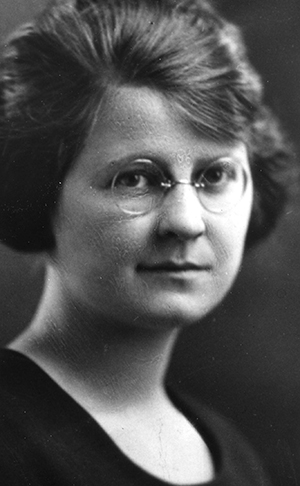A Miraculous Healing and a Mystic from New Jersey
Blessed Miriam Teresa Demjanovich died in 1927, at the age of 26, but she left behind an enduring legacy — and a young boy whose eyesight was miraculously healed.

Note: The story of Michael Mencer’s miraculous healing and Blessed Miriam Teresa’s holy life will be told on They Might Be Saints, airing Friday, May 8, at 5:30 p.m. Eastern time, on EWTN.
“Look what I found! Look what I found!”
Sister Maria Cassidy came running down the hallway of the motherhouse of the Sisters of Charity clutching an envelope that she desperately wanted to show to the others. She had been cleaning out a filing cabinet and discovered it at the bottom of the drawer between two hanging folders. The envelope marked “Save for later” contained a letter written decades earlier by a woman who believed she had witnessed a true miracle through the intercession of Sister Miriam Teresa Demjanovich.
The Case of Michael Mencer

The note related the cure of her son Michael, who as a young boy suffered from macular degeneration resulting in 20/400 vision. An ophthalmologist who examined him determined that he had a congenital problem. Glasses would not help him. With having vision only out of the sides of his eyes, he struggled in school and in life — even getting hit by a car — so the Sisters of Charity, the children at the school and the neighbors began praying to Sister Miriam Teresa specifically for Michael that his eyesight might improve.
His third-grade teacher at the time fortuitously happened to be the director of the Miriam Teresa League. One day she sent Michael home with a pamphlet and a round memento containing a relic — a tiny piece of hair from the head of Sister Miriam Teresa — to give to his mother. Michael recalled, “I was trying to look at it, trying to focus, with my peripheral vision but obviously I couldn’t get details on it.”
He walked home with it clutched in his hand and kept struggling to try to see it and suddenly everything changed: “I looked up and saw an orb but it didn’t hurt my eyes — I thought it was the sun — but then when I looked back down and moved my finger over it I could see the hair in the memento!”
His mother was cooking dinner and, when Michael got home, he came up to her to explain that Sister had given their family the relic and was looking directly at her. She knew immediately that he was healed. When they returned to the doctor, he could not explain the impossible change and simply smiled and said, “somebody has been praying!”
Dr. Mary Mazzarella, the medical consultant to the cause, researched all the available medical records including at the renowned Wills Eye Institute, a famous ophthalmological center in Pennsylvania that treats especially difficult cases. The doctors asked Michael’s mother why she brought a child with 20/20 vision to the clinic. The cause initially sought the input of four doctors — two pediatric ophthalmologists and two general physicians — and after consulting with colleagues, medical journals and other sources, each of them reported that they had no knowledge of anyone ever being cured of macular degeneration.
The report was sent to Rome, where it was examined by the Vatican’s Medical Commission for the Congregation for the Causes of Saints. Ultimately 19 doctors examined the medical record with all of them declaring it to be medically unexplainable. After the Congregation then determined that it was case of the singular intercession of Sister Miriam Teresa, the report was sent to Pope Francis, who declared on Dec. 17, 2013, that this was truly a miracle. This set the stage for the next step of the sainthood process.
The Cause of Sister Miriam Teresa Demjanovich

On March 26, 1901, Teresa Demjanovich was born in the city of Bayonne, New Jersey. Her parents Alexander and Johanna were hardworking and devout immigrants, in 1884 joining a flood of other young couples to form an enclave of Slovak families.
Sister Mary Canavan of the Sisters of Charity of St. Elizabeth in Convent Station, New Jersey, the vice-postulator of Blessed Teresa’s cause for canonization, studied her life in-depth over many years with the belief that her mysticism started at a very young age:
From the time she was about 3 years old, she had an understanding of the meaning of the Trinity, which we always consider a mystery. I think that it is safe to say that she spent her whole life in the presence of the Trinity in a mystical manner that is not afforded to most of us.
Her deeply religious family belonged to the Byzantine Ruthenian Catholic Church, St. John the Baptist in Bayonne. Teresa was baptized and confirmed in that rite when she was 5 days old. The family later moved to a Latin-Rite Catholic parish, where Teresa became deeply involved in parish life.
Sister Barbara O’Connell, a fellow member the Sisters of Charity of St. Elizabeth, learned of the saintly fellow Sister of Charity early on in her own vocation and admired her quiet and generous spirit.
“She would do anything to help anybody,” she said. This came to the fore when her mother took ill with her health gradually deteriorating. The family responsibilities of nurse and housekeeper fell squarely on the shoulders of Teresa, who accepted these duties cheerfully. At her mother's dying wish she enrolled at the College of St. Elizabeth, a school sponsored by the Sisters of Charity. It was the first Catholic college in New Jersey to award degrees to women.
Her fellow students began to recognize her uniqueness and sought her out in times of difficulty. “If you need help,” they would say, “go to Treat” — using the nickname she had acquired at the school. People knew that they could count on her for help.
She was an exceptional student, exhibiting mastery of all her subjects and eventually graduating from the college summa cum laude in May 1932.
She was well-known in college for her religious piety, but despite her incredible spiritual and mystical depths, to her friends Treat was just a good, normal, capable young woman — “truly an all-around girl,” said one of her classmates. She enjoyed occasionally going to New York City for shopping, and attending theater and concerts, but would find peace between classes and extracurricular activities making visits to the Blessed Sacrament and prayerfully saying the Stations of the Cross, as the Sisters did customarily.
When she became a Sister of Charity she was known for her devotion both in prayer and practice and was seen as a mystic by her confessor, who asked for her permission to have her handwritten conference notes. He gathered and published them after her death under the title Greater Perfection as a book of 26 chapters of her conferences that has been translated into a dozen different languages and is seen as a masterpiece of spirituality.
Her time as a Sister of Charity would be short-lived. Beginning around Christmastime in 1926, Teresa developed a sore throat and she was then sent in February to St. Elizabeth Hospital in Elizabeth, New Jersey. They finally determined that she had appendicitis and operated, but it was too late. The appendix had burst and she died of peritonitis.
Sister Miriam Teresa Demjanovich made her final vows in articulo mortis (“at the hour of death”) and died May 8, 1927, at the age of 26, after only two years as a religious sister. She left behind an enduring legacy and profound message of the universal call to holiness — that God wants everyone to be a saint.
In order for Blessed Miriam Teresa to be canonized, the cause needs to identify an additional healing miracle — an instantaneous, complete and lasting cure without medical treatment causing the change — that is worked through her singular intercession.

















